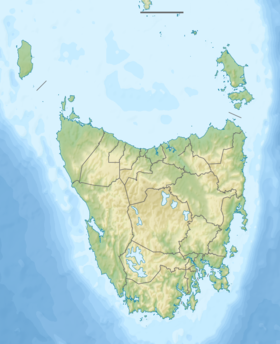The Wayatinah Power Station is a run-of-the-river[2] hydroelectric power station located in the Central Highlands region of Tasmania, Australia. The power station is situated on the Lower River Derwent catchment and is owned and operated by Hydro Tasmania.
| Wayatinah Dam | |
|---|---|
Location of the Wayatinah Dam in Tasmania | |
| Country | Australia |
| Location | Central Highlands Tasmania |
| Coordinates | 42°24′00″S 146°29′24″E / 42.40000°S 146.49000°E |
| Purpose | Power |
| Status | Operational |
| Opening date | 1956 |
| Owner(s) | Hydro Tasmania |
| Dam and spillways | |
| Type of dam | Embankment dam |
| Impounds | River Derwent |
| Height | 24 metres (79 ft) |
| Length | 549 metres (1,801 ft) |
| Dam volume | 125 thousand cubic metres (4.4×106 cu ft) |
| Spillways | 1 |
| Spillway type | Uncontrolled |
| Spillway capacity | 3,115 cubic metres per second (110,000 cu ft/s) |
| Reservoir | |
| Creates | Wayatinah Lagoon |
| Total capacity | 8,860 megalitres (313×106 cu ft) |
| Catchment area | 2,112 square kilometres (815 sq mi) |
| Surface area | 24.1 hectares (60 acres) |
| Wayatinah Power Station | |
| Coordinates | 42°25′12″S 146°31′48″E / 42.42000°S 146.53000°E |
| Operator(s) | Hydro Tasmania |
| Commission date | 1957 |
| Type | Run-of-the-river |
| Hydraulic head | 56 metres (184 ft) |
| Turbines | 3 x 15.3 MW (20,500 hp) English Electric Francis-type turbines |
| Installed capacity | 38.3 megawatts (51,400 hp) |
| Capacity factor | 0.85 |
| Annual generation | 440 gigawatt-hours (1,600 TJ) |
| Website hydro | |
| [1] | |
Technical details
editPart of the Derwent scheme that comprises eleven hydroelectric power stations, the Wayatinah Power Station is the sixth power station in the scheme and the second power station in the lower run-of-river system. The power station is located aboveground below Wayatinah Lagoon, a small storage created by the rock-filled Wayatinah Dam on the Derwent River below its junction with the Nive River. Water from the Derwent from Liapootah Power Station and spill from Liapootah Dam flows into Wayatinah Lagoon. Water in the lagoon is diverted by a 2-kilometre (1.2 mi)-long tunnel to two low pressure woodstave pipelines, each 1.3 kilometres (0.81 mi) long. It then descends 56 metres (184 ft) through three steel penstocks to the Wayatinah Power Station. The tunnel intake structure is provided with two vertical lift, gravity close intake gates designed to cut off full flow. Each of the three steel penstocks is provided with a hilltop valve designed to close under full flow.[2][3]
The power station was commissioned in 1957 by the Hydro Electric Corporation (TAS) and the station has three 15.3-megawatt (20,500 hp) English Electric Francis turbines, with a combined generating capacity of 38.3 megawatts (51,400 hp) of electricity.[4] Within the station building, each turbine has a fully embedded spiral casing and water flow is controlled by a spherical rotary main inlet valve and a turbine relief valve designed to prevent spiral casing overpressure. The station output, estimated to be 440 gigawatt-hours (1,600 TJ) annually,[1] is fed to TasNetworks' transmission grid via an 11 kV/220 kV three-phase English Electric generator transformer to the outdoor switchyard. An 11 kV indoor switchgear system also supplies a distribution yard that supplies power to the local area from Wayatinah village to Hamilton and includes the power stations of Liapootah, Wayatinah, Catagunya, Repulse and Cluny.[2]
See also
editReferences
edit- ^ a b "Register of Large Dams in Australia". Dams information. Australian National Committee on Large Dams. 2010. Archived from the original (Excel (requires download)) on 12 December 2013. Retrieved 23 June 2015.
- ^ a b c "Wayatinah Power Station Fact Sheet: Technical fact sheet" (PDF). Energy: Our power stations. Hydro Tasmania. Retrieved 16 January 2015.
- ^ "Derwent: Wayatinah Power Station". Energy. Hydro Tasmania. Retrieved 5 July 2015.
- ^ Austral Archaeology Pty Ltd; Terry, Ian (April 2007). "Wayatinah Power Station—Conservation Management Plan" (PDF). Retrieved 1 February 2012.[permanent dead link]
External links
edit- Hydro Tasmania page on the Lower Derwent
